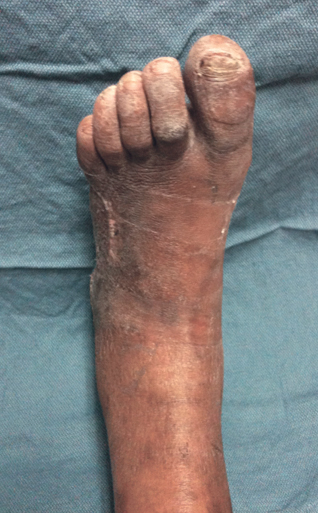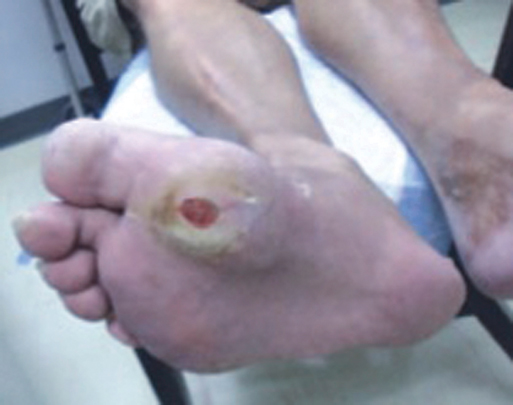There is a continuum from simple neuropathic to complex neuroischemic ulceration, and both types have similar distributions on the foot. Neuropathy becomes evident in 50% of diabetics who have had the disease for 10 years. The classic claw toe causes the first interphalangeal joint to be arched so that it can rub against the top of the toe box of the shoe and can cause an ulcer. Likewise, the distal aspect of the claw toe points directly downward and strikes the sole of the shoe instead of the pad of the toe, causing the tip of the toe to ulcerate (Figure 1). Ulceration can develop on the plantar surface over any of the metatarsal heads; ulcerations over the second and third are the most common. The offloading of the metatarsal high pressure point with appropriate orthotics allows the ulcer to heal, but mal perforans ulcers are prone to recur. Resection of the metatarsal head or the metatarsophalangeal joint offloads the plantar pressure but at the risk of producing transfer lesions under adjacent metatarsal heads (Figure 2). The neuro-osteoarthropathic foot, also known as the Charcot foot, is often characterized by a rocker-bottom appearance. This collapse of the midfoot increases plantar pressure at the point of dislocation. Commonly, the dislocated navicular and medial cuneiform bones produce large ulcers along the plantar medial aspect of the foot and a dislocated cuboid results in a plantar lateral ulceration (Figure 3). Offloading the plantar surface is essential, usually with a total contact cast or its equivalent. When the cast is properly changed on a weekly basis, most Charcot midfoot ulcers can be healed within 3 to 6 months.
Cutaneous Ulcers in the Neuroischemic Diabetic Foot
Distribution
![]()
Stay updated, free articles. Join our Telegram channel

Full access? Get Clinical Tree


Thoracic Key
Fastest Thoracic Insight Engine


